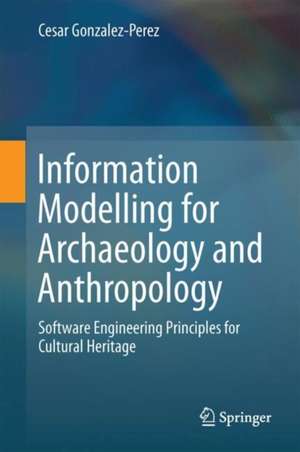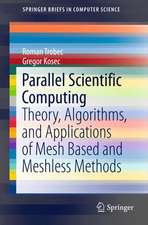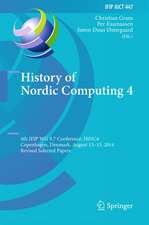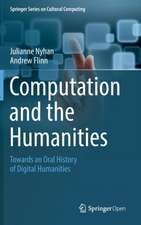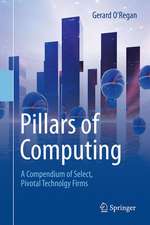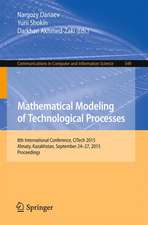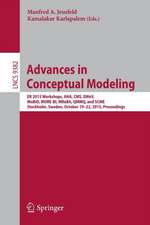Information Modelling for Archaeology and Anthropology: Software Engineering Principles for Cultural Heritage
Autor Cesar Gonzalez-Perezen Limba Engleză Hardback – 25 ian 2018
Information modelling tasks are a vital aspect of work and study in such disciplines as archaeology, anthropology, history, and architecture. Yet the concepts and methods behind information modelling are rarely covered by the training in cultural heritage-related fields. With the increasing popularity of the digital humanities, and the rapidly growing need to manage large and complex datasets, the importance of information modelling in cultural heritage is greater than ever before. To address this need, this book serves in the place of a course on software engineering, assuming no previous knowledge of the field.
Topics and features:
- Presents a general philosophical introduction to conceptual modelling
- Introduces the basics of conceptual modelling, using the ConML language as an infrastructure
- Reviews advanced modelling techniques relating to issues of vagueness, temporality and subjectivity, in addition to such topics as metainformation and feature redefinition
- Proposes an ontology for cultural heritage supported by the Cultural Heritage Abstract Reference Model (CHARM), to enable the easy construction of conceptual models
- Describes various usage scenarios and applications of cultural heritage modelling, offering practical tips on how to use different techniques to solve real-world problems
Dr. Cesar Gonzalez-Perez is a Staff Scientist at the Institute of Heritage Sciences (Incipit), within the Spanish National Research Council (CSIC), Santiago de Compostela, Spain.
| Toate formatele și edițiile | Preț | Express |
|---|---|---|
| Paperback (1) | 397.89 lei 43-57 zile | |
| Springer International Publishing – 6 iun 2019 | 397.89 lei 43-57 zile | |
| Hardback (1) | 432.96 lei 43-57 zile | |
| Springer International Publishing – 25 ian 2018 | 432.96 lei 43-57 zile |
Preț: 432.96 lei
Preț vechi: 541.20 lei
-20% Nou
Puncte Express: 649
Preț estimativ în valută:
82.84€ • 86.73$ • 68.55£
82.84€ • 86.73$ • 68.55£
Carte tipărită la comandă
Livrare economică 07-21 aprilie
Preluare comenzi: 021 569.72.76
Specificații
ISBN-13: 9783319726519
ISBN-10: 331972651X
Pagini: 400
Ilustrații: XIX, 449 p. 216 illus.
Dimensiuni: 155 x 235 mm
Greutate: 0.84 kg
Ediția:1st ed. 2018
Editura: Springer International Publishing
Colecția Springer
Locul publicării:Cham, Switzerland
ISBN-10: 331972651X
Pagini: 400
Ilustrații: XIX, 449 p. 216 illus.
Dimensiuni: 155 x 235 mm
Greutate: 0.84 kg
Ediția:1st ed. 2018
Editura: Springer International Publishing
Colecția Springer
Locul publicării:Cham, Switzerland
Cuprins
Part I: Introduction to Conceptual Modelling.- What Is Conceptual Modelling?.- Premises and Foundations of Conceptual Modelling.- Benefits and Applications of Conceptual Modelling.- Part II: The Basics of Conceptual Modelling.- Objects.- Classes.- Attributes.- Enumerated Types.- Associations.- Generalization and Specialization.- Recap of Part II.- Part III: Advanced Conceptual Modelling.- Advanced Enumerated Types.- Advanced Features.- Advanced Generalization.- Model Architecture.- Vagueness.- Temporality.- Subjectivity.- Feature Redefinition.- Metainformation.- Recap of Part III.- Part IV: A Model of Cultural Heritage.- An Ontology for Cultural Heritage.- Overview of CHARM.- CHARM General Concepts.- Tangible Entities.- Agents.- Manifestations and Performative Entities.- Occurrences.- Abstract Entities.- Representations.- Valorizations.- Derived Entities.- Recap of Part IV.- Part V: Applying Conceptual Modelling.- Modelling Patterns.- ConstructingQuality Models.- The Modelling Process.- Extending Models.- Developing Database Systems.- Recap of Part V.- Solutions to Exercises.- List of CHARM Model Elements.
Notă biografică
Dr. Cesar Gonzalez-Perez is a Staff Scientist at the Institute of Heritage Sciences (Incipit), within the Spanish National Research Council (CSIC), Santiago de Compostela, Spain.
Textul de pe ultima copertă
This unique text/reference reviews the key principles and techniques in conceptual modelling which are of relevance to specialists in the field of cultural heritage.
Information modelling tasks are a vital aspect of work and study in such disciplines as archaeology, anthropology, history, and architecture. Yet the concepts and methods behind information modelling are rarely covered by the training in cultural heritage-related fields. With the increasing popularity of the digital humanities, and the rapidly growing need to manage large and complex datasets, the importance of information modelling in cultural heritage is greater than ever before. To address this need, this book serves in the place of a course on software engineering, assuming no previous knowledge of the field.
Topics and features:
Dr. Cesar Gonzalez-Perez is a Staff Scientist at the Institute of Heritage Sciences (Incipit), within the Spanish National Research Council (CSIC), Santiago de Compostela, Spain.
Information modelling tasks are a vital aspect of work and study in such disciplines as archaeology, anthropology, history, and architecture. Yet the concepts and methods behind information modelling are rarely covered by the training in cultural heritage-related fields. With the increasing popularity of the digital humanities, and the rapidly growing need to manage large and complex datasets, the importance of information modelling in cultural heritage is greater than ever before. To address this need, this book serves in the place of a course on software engineering, assuming no previous knowledge of the field.
Topics and features:
- Presents a general philosophical introduction to conceptual modelling
- Introduces the basics of conceptual modelling, using the ConML language as an infrastructure
- Reviews advanced modelling techniques relating to issues of vagueness, temporality and subjectivity, in addition to such topics as metainformation and feature redefinition
- Proposes an ontology for cultural heritage supported by the Cultural Heritage Abstract Reference Model (CHARM), to enable the easy construction of conceptual models
- Describes various usage scenarios and applications of cultural heritage modelling, offering practical tips on how to use different techniques to solve real-world problems
Dr. Cesar Gonzalez-Perez is a Staff Scientist at the Institute of Heritage Sciences (Incipit), within the Spanish National Research Council (CSIC), Santiago de Compostela, Spain.
Caracteristici
Conveys knowledge to cultural heritage specialists that has previously been unavailable to them, as its only sources are technical texts in software and knowledge engineering Builds incrementally from scratch up to advanced topics, so that it can be used at various proficiency levels Provides a unique combination of true-and-tested content that is commonly accepted in mainstream literature, plus some recent research results
